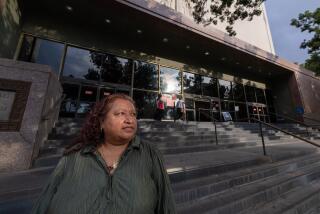Overruns Put Law Firm on Defensive for New Contract
- Share via
County officials felt they were paying too much for lawyers who defend the poor even before they spotted a spate of questionable bills last fall.
In one instance, officials said, a partner in Ventura-based Conflict Defense Associates paid an investigator $210 to build file cabinets. In another, an investigator earned $30 an hour to deliver clean clothes to a jailed inmate.
But the bills from a Ventura doctor really raised eyebrows, said budget analyst Robert Sherman.
The doctor charged $1,750 to evaluate an inmate at the County Jail, including $375 just to drive there from across town, Sherman said. Another day, the same doctor charged $2,000 to see a patient at a mental hospital in Norwalk, with travel charges of $1,250 for the 160-mile round trip.
Officials said these are a few glaring examples of wasteful spending practices by the law firm that has held the county’s contract for representing poor defendants for 18 years.
County officials and judges cite the examples as reasons the county is pushing hard to lower costs, possibly by hiring a bare-bones, San Joaquin Valley law firm.
“There is no way of telling how much padding is going on,” Sherman said. “We could spend all of our time checking their bills if we wanted to. But $1,250 to drive to Norwalk seems excessive. You could fly to Washington, D.C., full-fare, round-trip, for that.”
Cases are referred to Conflict Defense Associates when the public defender’s office declares a conflict of interest, most often when there are multiple defendants. In addition to attorney fees, the county advances $895,000 each year to cover expenses.
*
Criticism has focused on the firm’s lax oversight of those costs.
“If it was their money being spent on that doctor, they might have taken care of that problem beforehand,” said Charles W. Campbell, presiding judge of the Superior Court. “Maybe they would have worked out an agreement on how much it will cost. It’s an issue of being careful about how you are being billed and what you are paying for these things.”
Joel Steinfeld, one of four partners in Conflict Defense Associates, said the firm has “definitely gotten the message” that the county is fuming about budget overruns. The firm has exceeded its $1.3 million annual contract in each of the last three years, requiring the county to make extra payments totaling $1.4 million.
Although Steinfeld defends some of the expenses as legitimate, he said the law firm’s principal attorneys have met with the judiciary and are committed to changing the way they do business.
“We’re not perfect, but we’re trying to correct any flaws we have in the system,” Steinfeld said.
*
Local lawyers say the prospect of getting edged out by a competitor has been a wake-up call for the network of 22 lawyers who make up Conflict Defense Associates.
The firm’s principal attorneys--Steinfeld, James Farley, Willard Wiksell and Charles Cassy--have represented defendants in high-profile cases for nearly two decades. For 18 years, there was no other bidder for the contract.
But this spring, fed up with Conflict Defense Associates’ cost overruns, the county aggressively sought competing bids, advertising in legal journals and on the Internet. The effort produced a competing bid by John A. Barker & Associates, a law firm based in Madera, just north of Fresno. Barker’s $1.1-million proposal undercuts by more than half the $2.4-million bid from Conflict Defense Associates. Barker says he cuts costs by doing investigations in-house and shuffling 53 lawyers among his various offices to meet demand.
His firm provides defense services in five counties, including a $2-million conflict-defense contract in Fresno County. Ventura County judges are taking notice of Barker’s attention to the bottom line, Campbell said.
But comparing Barker’s proposal with Conflict Defense Associates’ is difficult because the details of each firm’s proposal are still under seal. Measuring Conflict Defense Associates’ efficiency against the public defender’s office, which represents 90% of poor defendants, is also difficult because the public agency has no reliable cost data to make an accurate comparison.
*
But a straight per-case cost analysis by the auditor-controller’s office in 1992 showed that the private attorneys spent $623 per case compared with $187 by the public defender.
Steinfeld said those numbers are flawed because Conflict Defense Associates handles a greater percentage of serious and costly cases. Its lawyers must also pay their own overhead costs for office space, utilities and staff, he said.
Although there are variances between the actual pay of the private and public defense lawyers, judges stress that that is not viewed as a significant issue. Pay for deputy public defenders begins at $35,000 and escalates to a maximum of $92,000 for a few senior attorneys, officials said.
Public Defender Kenneth Clayman earns $116,000 a year. The government employees receive an array of benefits.
By comparison, Conflict Defense Associates’ four partners each receive a flat fee of $117,000 annually, with no benefits. They serve as trial lawyers in major cases as well as managing the caseload, which averages about 2,000 felony and misdemeanor cases a year. But the four are free to take other cases as well. Associate attorneys earn $1,000 per felony case and average five cases a month, Steinfeld said. Additionally, they are paid $275 to handle each misdemeanor case, he said. The attorneys earn a minimum annual salary of about $60,000.
*
Salaries have not been the primary concern, county officials said. And few are disputing Conflict Defense Associates’ reputation for aggressively defending clients. The firm has never had a case overturned on appeal because of shoddy work. “They do a good job,” Campbell said. “I don’t think there has ever been a concern by the judges about their representation.”
But the firm’s spiraling expenses have concerned county administrators for nearly a decade. Three reports issued since 1991 have called for reform and come to a similar conclusion: Conflict Defense Associates is not efficient because it has no competition.
The reports recommended that the county attempt to seek other bidders or consider opening an alternate public defender’s office. A 1992 audit concluded the county could save up to $435,000 a year by establishing a second public office.
A 1997 review found that expert witness and investigative costs were rising dramatically, in part because Conflict Defense Associates did not rigorously screen billings. Consultant Briana Lane recommended that the county discontinue its practice of advancing the firm about $895,000 at the beginning of the year to pay overhead expenses.
The county should instead require Conflict Defense Associates to front payments for experts and investigative fees and then be reimbursed by the county. That would motivate the attorneys to more closely review the expenses, the consultant advised.
*
A third report issued earlier this year makes the same recommendations. Steinfeld said costs began rising because changes in the law required the attorneys to more aggressively defend clients.
The three-strikes law, enacted in 1994, mandates a 25-years-to-life sentence for a third-time felon. The high-stakes cases mean that attorneys more often employ investigators and experts to assist in a defense, he said.
There has also been a spate of costly capital murder cases in recent years. In those cases, each defendant is assigned two lawyers and expenses for experts often soar, Steinfeld said.
The district attorney’s budget has grown an average of 10% a year, but Conflict Defense Associates has remained locked into contract amounts set in 1993, he said. “We obviously would have loved to have stayed within our budget,” he said. “But the ballgame changed.”
Steinfeld defended some of last year’s eye-opening bills as legitimate expenses. The filing cabinets built by an investigator were needed to store homicide files for five years as mandated in their contract, he said.
He agreed that the travel fees charged by the Ventura doctor appear exorbitant. But some doctors argue that they lose hundreds of dollars any time they leave their office to visit a jailed inmate, Steinfeld said.
“I don’t agree, but that is the doctor’s rationale,” he said. “And he was very qualified for what had to be done.”
Still, Steinfeld said, he and his partners have instituted changes aimed at keeping a tighter lid on costs. For instance, investigators no longer charge for running a suit over to the jail, he said.
And, in the future, they will negotiate expert fees that are reasonable, Steinfeld said. In the meantime, the partners are preparing written responses to questions asked by judges in a meeting last week.
The Barker firm is also answering questions, Sherman said. The judiciary will review final proposals and recommend a bidder in the next two weeks. The bench’s recommendation will go before the county supervisors for approval in July.
Campbell said the court’s 26 judges are “very uncomfortable” with the decision ahead.
“You’ve got people you’ve known for a long time and respected,” he said. “But you have the fiscal responsibility as well.”
More to Read
Sign up for Essential California
The most important California stories and recommendations in your inbox every morning.
You may occasionally receive promotional content from the Los Angeles Times.











